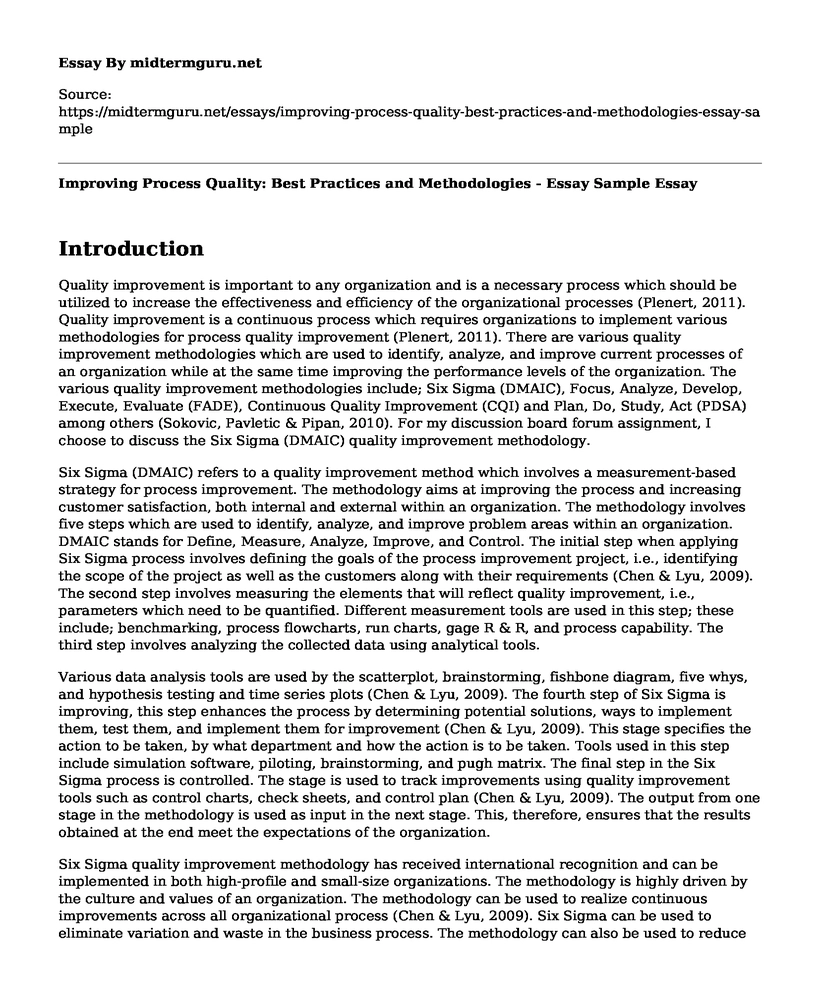Introduction
Quality improvement is important to any organization and is a necessary process which should be utilized to increase the effectiveness and efficiency of the organizational processes (Plenert, 2011). Quality improvement is a continuous process which requires organizations to implement various methodologies for process quality improvement (Plenert, 2011). There are various quality improvement methodologies which are used to identify, analyze, and improve current processes of an organization while at the same time improving the performance levels of the organization. The various quality improvement methodologies include; Six Sigma (DMAIC), Focus, Analyze, Develop, Execute, Evaluate (FADE), Continuous Quality Improvement (CQI) and Plan, Do, Study, Act (PDSA) among others (Sokovic, Pavletic & Pipan, 2010). For my discussion board forum assignment, I choose to discuss the Six Sigma (DMAIC) quality improvement methodology.
Six Sigma (DMAIC) refers to a quality improvement method which involves a measurement-based strategy for process improvement. The methodology aims at improving the process and increasing customer satisfaction, both internal and external within an organization. The methodology involves five steps which are used to identify, analyze, and improve problem areas within an organization. DMAIC stands for Define, Measure, Analyze, Improve, and Control. The initial step when applying Six Sigma process involves defining the goals of the process improvement project, i.e., identifying the scope of the project as well as the customers along with their requirements (Chen & Lyu, 2009). The second step involves measuring the elements that will reflect quality improvement, i.e., parameters which need to be quantified. Different measurement tools are used in this step; these include; benchmarking, process flowcharts, run charts, gage R & R, and process capability. The third step involves analyzing the collected data using analytical tools.
Various data analysis tools are used by the scatterplot, brainstorming, fishbone diagram, five whys, and hypothesis testing and time series plots (Chen & Lyu, 2009). The fourth step of Six Sigma is improving, this step enhances the process by determining potential solutions, ways to implement them, test them, and implement them for improvement (Chen & Lyu, 2009). This stage specifies the action to be taken, by what department and how the action is to be taken. Tools used in this step include simulation software, piloting, brainstorming, and pugh matrix. The final step in the Six Sigma process is controlled. The stage is used to track improvements using quality improvement tools such as control charts, check sheets, and control plan (Chen & Lyu, 2009). The output from one stage in the methodology is used as input in the next stage. This, therefore, ensures that the results obtained at the end meet the expectations of the organization.
Six Sigma quality improvement methodology has received international recognition and can be implemented in both high-profile and small-size organizations. The methodology is highly driven by the culture and values of an organization. The methodology can be used to realize continuous improvements across all organizational process (Chen & Lyu, 2009). Six Sigma can be used to eliminate variation and waste in the business process. The methodology can also be used to reduce defect by identifying areas that are likely to affect the overall quality expectation of a service or product. Lastly, Six Sigma quality improvement methodology helps an organization to identify areas of improvement and thus direct resources towards it continuously (Klefsjo, Wiklund, & Edgeman, 2001). This results in the improvement of the existing business products and service while at the same time assist in the development of new high-quality products, thus achieving continuous improvement of the organizational processes.
References
Chen, M., & Lyu, J., (2009). A Lean Six-Sigma approach to touch panel quality improvement. Production Planning and Control, 20(5), 445-454.
Klefsjo, B., Wiklund, H., & Edgeman, R. L. (2001). Six sigma saw as a methodology for total quality management. Measuring business excellence, 5(1), 31-35.
Plenert, G., (2011). Strategic continuous process improvement. McGraw-Hill Publishing.
Sokovic, M., Pavletic, D., & Pipan, K. K., (2010). Quality improvement methodologies-PDCA cycle, RADAR matrix, DMAIC, and DFSS. Journal of achievements in materials and manufacturing engineering, 43(1), 476-483.
Cite this page
Improving Process Quality: Best Practices and Methodologies - Essay Sample. (2023, Jan 08). Retrieved from https://midtermguru.com/essays/improving-process-quality-best-practices-and-methodologies-essay-sample
If you are the original author of this essay and no longer wish to have it published on the midtermguru.com website, please click below to request its removal:
- Research Paper on Teamwork
- How Can First Hotel Mayfair Enhance Guest Satisfaction? - Paper Example
- Top 5 Things to Better Manage Medical Risk in Hospitals - Essay Sample
- Essay Sample on Fire Fighters: Line of Duty Death
- Essay Sample on Leadership Collaboration to Enhance Minimal Expenditure
- Talent Acquisition: Attracting & Retaining Skilled People for Long-Term Goals - Essay Sample
- Stakeholders in Health Information Management System: Vila Health Independence Medical Center - Essay Sample







